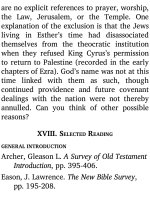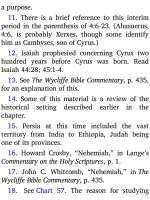Jensens survey of the old testament adam 275
Bạn đang xem bản rút gọn của tài liệu. Xem và tải ngay bản đầy đủ của tài liệu tại đây (117.08 KB, 4 trang )
and people, judgment for sin, and blessing
for righteousness. One cannot help but
observe that the Gospel of God has been the
same message for sinners of all generations.
3. Features. The most notable feature of
this book is its repeated pattern of
discourse.17 Three steps are involved
(example is shown):
A rmation (charge or accusation): “You are
robbing Me” (3:8).
Interrogation (introduced by “you say”):
“But you say, ‘How have we robbed
Thee?’” (3:8).
Refutation (answer to the question): “In
tithes and contributions” (3:8).
The common repeated phrase in these
discourses is “you say.” It appears eight
times: 1:2,6,); 2:14,17; 3:7,8,13.
Another feature of Malachi’s message is
his strong emphasis on the Law of God (read
4:4). Also, the book surpasses all other
prophetic books in the proportion of verses
spoken by the Lord to Israel (forty-seven out
of the total of fifty-five).
4. The place of Malachi in the Bible canon.
Malachi is both a conclusion and a
connecting link. It concludes the story of
Israel for the span of 2000-400 B.C., and it is
the last prophetic voice of the Old
Testament. The book connects the Old
Testament with the New Testament by its
prophecies of John the Baptist and Christ’s
rst advent. Its “messianic ashes (3:1-6;
4:2) prepare us for the NT revelation and
focus our attention on Him who alone is the
world’s hope.”18 Beyond that, the book
reaches into the end times when it
prophesies about the nal day of the Lord
(second advent).
II. SURVEY
Chart 117 is a survey chart showing the
general pattern and highlights of Malachi.
Study it carefully after you have scanned the
entire book and have completed the other
usual procedures of survey study. Then
follow the study suggestions given below.
(Always read the Bible passages which are
cited.)
1. The
rst verse (1:1) is a typical
introduction to the book.
2. The last paragraph (4:4-6) is not only a
conclusion to the book, but also a tting
conclusion to the whole Old Testament.
3. The rst half of the book (1:2—3:15) is
mainly about sin. What subjects does
Malachi write about after 3:16?
4. What bright prophecy appears at 3:1-6?
Why do you think this prophecy is
mentioned in the middle of the section
about the people’s sins?
5. How does the chart compare the
beginning and end of Malachi’s prophecy?
6. Read the whole book again, following
the chart’s outline as you read. Try to justify
the various outlines on the basis of the Bible
text.
7. Note the key words and key verses
shown on the chart. Can you add to the list?









